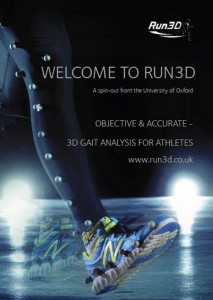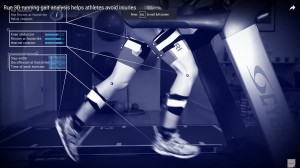The advantages of 3D gait analysis:
- The gold standard of gait analysis
- Analyses your motion in three body planes
- Measures leg rotations not possible with video camera analysis
- Compares your values with a normal database of uninjured runners
- Realtime gait re-training
- Based on decades of research
- Brings the science laboratory to the clinical environment
- Optimise injury rehabilitation and footwear choice
Have a look at some examples on our Facebook page
If you would like more information or have a question, please contact us.
What is 3D gait analysis?
Three-dimensional gait analysis is a non-invasive method of accurately measuring the way you move. Small, spherical reflective markers are attached to your body and the three-dimensional positions of these markers are measured using infrared cameras as you move. Run3D has three infrared cameras that record the three-dimensional positions of each marker at a frequency of 200Hz (two hundred times a second).
The three-dimensional positions of the markers are then used to create an exact computer model of you running. The personalised model is used to accurately calculate your joint angles in all three planes of human movement. For example, we measure how much your knee extends and flexes as you run, how much it rotates and how much it moves sideways.
Infrared cameras and custom-built software enable a highly accurate assessment of your biomechanics
Run3D uses the 3D GAIT system, which has been developed by the world-leaders in running injury biomechanics at the Running Injury Clinic at the University of Calgary. 3D GAIT combines infrared motion capture equipment with custom-built software and the world’s largest biomechanical database to provide you with the most accurate assessment of your biomechanics that is currently available. Your individual data is compared to the normal database of several hundred runners.
Our analysis enables us to identify the subtle biomechanical problems that are likely to have caused your injury. These abnormalities are often impossible to detect by eye or with video based systems. By identifying the underlying mechanisms that caused your injury in the first place, we can optimise your rehabilitation protocols and reduce the likelihood that the injury reoccurs.
3D GAIT is based on decades of research from some of the world’s leading institutions, including the University of Calgary and the University of Oxford.
What is the difference between the service provided by Run3D and the free biomechanical assessment advertised by my local running shop?
Your body endures a force equal to 2.5 times your body-weight with every step you run. You run a mile in approximately 1900 steps. Therefore, if you run 40 miles a week, you take nearly 2 million running steps each year. The repetitive and demanding loads placed on the body mean that even very small differences in your running patterns might lead to the development of a running injury.
Research has shown that only three-dimensional assessments are accurate enough to detect the small motion patterns that might cause a running injury. Since most running shops only use one or two cameras, they can only measure your biomechanics in 2D, which are often inadequate for carrying out an accurate and reliable biomechanical assessment. At Run3D we use three infrared cameras to measure your biomechanics in three dimensions. This is a very specialised service and use the most advanced method of three-dimensional clinical motion analysis that is available at this time.
Surely all I need is a good pair of shoes?
Whilst it is common for people to be advised running shoes based on arch profile, footprint shape or heel position on video analysis, there is no scientific research to support this approach. A review of all the available scientific papers on the subject showed that there is no evidence on which to base shoe recommendations.
Some studies have tried to analyse the benefit of different shoe types (neutral, stability, motion control) on foot types with no consistent evidence to demonstrate that one shoe is better for a given foot type. Indeed, the only finding that seems to be a good guide is comfort – the most comfortable shoes insert can reduce injury rate and the most comfortable shoe can improve running economy.
However, it is clear from clinical experience that having the right shoe for each individual has the potential to reduce the injury rate.
By performing a detailed 3D gait analysis we can get a much clearer idea of the need for a given shoe type.

 Call 020 8502 1777 or
Call 020 8502 1777 or  online form
online form
